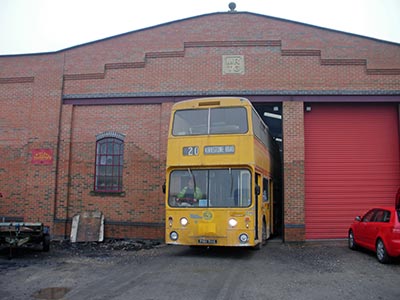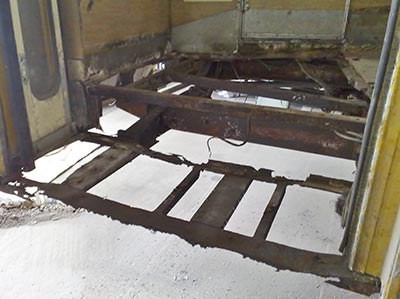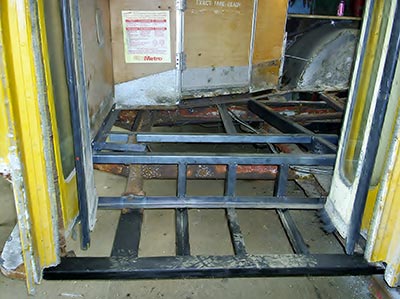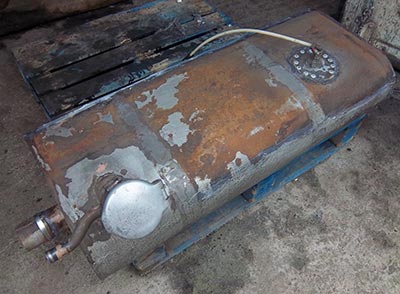Chesterfield 114 - The story continues.....
by Paul Hopkinson - Email : paul.hopkinson@chesterfield123.org.uk
 Sheepbridge Commercials
Sheepbridge CommercialsBack in the year 2000, I wrote the article “Window Rattler's Return”, which gave an account of the acquisition and collection of ex-Chesterfield Leyland Atlantean/Northern Counties PNU 114K, and that account ended with 114 being safely ensconced in her new home at Sheepbridge Commercials in Chesterfield. Some eleven and a half years have passed since those words were written and it is time to bring the story up to date.
During the winters of 2000/2001 and 2001/2002, the restoration arm of the 123 group was still in its original incarnation of the individuals that had recently restored 124, and this group of us set about work on 114 to establish the extent of the work required and to start on the work in earnest. Some trips were made to the Barnsley scrap yards which were then still dismantling a fair number of steel framed Northern Counties bodied Atlanteans and Fleetlines, and some useful spares were acquired. However, as the Selnec Preservation Society had found out, a lot of the glass in 114 was non-standard, thus there are still several pieces outstanding to this day.
We got stuck into the bodywork round the back of the bus and proceeded to remove the floor in the rear of the lower saloon and all the iron work that supported it as it was badly rusted. There was quite a considerable amount of rust in the chassis and it had weakened. Some sections were cut out and new sections welded in. However, the enormity of the task and the conditions we were working in (which were far from ideal!) took their toll. Work on 114 ground to a halt and we were left with a bus where you could stand next to the centre doors and look at the rear axle and wheels, and the puddle it was standing in slowly increasing in size until it touched the bottom of the diff. In the meantime the group had acquired ex-Chesterfield Daimler Fleetline/Roe 139 (KWJ 139P), which had been fitted out for Derbyshire County Council as a mobile computer classroom some years before and had now been replaced.
It was during that year that the group were faced with a choice of whether to spend a significant amount of money to help with the building project at the Midland Railway Centre, which would ultimately provide covered accommodation for 114, 123 and 124, or use the money to purchase 154 and 159 when they came out of service with TM Travel. Unfortunately, the group could not agree on this, with the majority wishing to go for the undercover accommodation. This resulted in some members going their separate ways and Fleetline 139 going for scrap without the planned component recovery taking place.
Whilst this was happening, things went from bad to worse at the storage yard. The puddle became larger and deeper and some toe-rags broke into the yard one night, got 124 going and crashed it into a grass bank. Fortunately, they were spotted and chased off but not before they had broken another one of the odd windows in 114. The damage to 124 was fairly minimal but very inconvenient.
It was arranged that 114 be taken to the Midland Railway Centre (MRC) that weekend (even though the building was incomplete) thus it could be kept safe. 123 and 124 would soon follow. A tow was arranged for Saturday 14th September 2002.
A group of us convened at 114 on the Saturday morning and waited for Bothams V8 Scania tractor unit to come and take us to the MRC. A towing eye was screwed in, the radiator refilled (it was leaking almost as quickly as we could pour water in) and the tractor unit connected. The towing eye sheared off as soon as the weight was taken up so we had to send for some burning tackle to improvise a towing hitch on the front crossmember. Once we had done this and connected the tractor unit up once more, it soon became obvious that we could not get the traction to pull 114 back out on to the road. Thus we had to disconnect the tractor again, put the half shafts back in and drive 114 out to the road. The radiator was once again refilled and the tractor reconnected and 114 was towed to the MRC with yours truly at the wheel with the engine running to keep the air pressure up. There was one slight mishap on the way when the connection became loose in Alfreton. On arrival the tow truck was disconnected, the half shaft put back in and 114 was driven into her new home (backwards!).
Whilst 114 was now undercover, work was no longer taking place. 124 was rallied for a couple of seasons but needed further work, and several years standing outside had taken their toll on 123. I was doing the repairs required to 123 almost single handed and it was decided to concentrate on this and treat 123 to a full repaint once the repairs were complete. However, finances for 114 had been building and the radiator was removed and sent away for reconditioning in March 2005 and was replaced on its return. Other vehicles were acquired and restored over the ensuing years as more members became involved, and 124 was resurrected in 2008, the remedial work done and has been rallied ever since.
Throughout the MRC years, 114 occasionally drove out of the shed for the road/rail rally in July and once made it as far as the fork in the entrance road but otherwise, little happened between 2002 and 2010.
With the demise of TM Travel as an independent company at the end of 2009, they decided to quit their former depot at Staveley and it was to be progressively run down until closure in May 2010. There was a workshop with pits not being used and it was thought that some useful work could be done on 114 over these few months. It was decided to tow 114 to Staveley and take advantage of this, even if we had to tow her back in May. The first job was to get her going again, which was easy enough, but building the air was a different story entirely. There was also the added problem of having to practically empty the shed in order to get her out! We made a plan to get her out and to the front of the shed one weekend and then come back the next with the tow truck. The following weekend (23rd January 2010) we came back with some rubber pipe, a hacksaw and lots of Jubilee clips and we managed to clear the shed of recalcitrant Bristol VRs, an AEC Regal and a Scammell lorry, amongst other things, and got 114 to the front.
 Midland Railway Centre
Midland Railway CentreWe returned two Saturdays later (6th February 2010) and got 114 out and waited and waited for the tow truck whilst it cleared the highways of failed Stagecoach Darts. Once the tow truck arrived we lifted 114 and fastened her on, another phone call came in about another failed Stagecoach bus which would be the tow truck’s next job. They were having a really bad day (you get them like that in the bus industry…!!)
Of course, everything didn’t go smoothly. We blew out an offside rear inner tyre on the motorway, but we were almost in sight of Staveley when it happened so we were able to continue at reduced speed and get there in (almost) one piece.
 Arriving at Staveley, Saturday 6th February 2010
Arriving at Staveley, Saturday 6th February 2010That afternoon, 114 took up residence on one of the redundant inspection pits which allowed work to (re) start in earnest.
It was decided that a complete set of road springs was needed, the brakes needed overhauling and all the mild steel air piping would need replacing. We gladly accepted an offer of help with the front brakes and air piping from a friend, who did sterling work overhauling the front brakes and replaced the nearside wheel bearing, as well as the front brake chambers. He also spent some time getting the old air piping off and having it re-made to pattern. Unfortunately, he took ill soon after this without finishing the air piping.
Some springs and shackle pins were made for us by Owens at Rotherham, and new brass top hat bushes were fitted where necessary, from our own stocks. Over several weekends we removed the old front springs and replaced them with the new ones.
At the beginning of May 2010 the old TM Travel garage closed down, but we were fortunate enough to have sourced a nearby industrial unit at reasonable cost. 114 was moved there that weekend. We had sourced a set of vehicle lifts which were overhauled and re-commissioned as there were no pits in the new unit.
Work continued on the suspension, replacing the rear springs and the rear spring brake chambers. The nearside rear spring had decided it wanted to stay put and we had to cut through the spring eye to release the shackle pin, and the U bolts didn’t want to undo. The offside rear spring was the last one we did and we achieved this in less than half the time we did the first one, and by now we no longer had the use of the oxy-acetylene cutting gear. However, we had a whale of a time with the brake pins which proved somewhat recalcitrant, and ended up drilling them out!
 Spring mounting
Spring mountingIn the mean time, all the superfluous piping that had once served the auto lube was removed, the job being taken over a long time ago by traditional grease nipples and a grease gun. The iron work that had once supported the rear lower deck floor over the axle was also welded back into place. With hindsight, it would have been easier to have left it until the road spring replacement had been completed.
The next job we tackled was the lower deck floor. There was a hole on the platform where the boards had rotted, so we decided to work from the front to the back, where the floor was already missing. We took the boards off the front step, and it was apparent that there was very little holding it up. The treadmaster was the only thing on the platform that prevented you from falling on to the road! The supporting iron work was paper thin in places and the boarding broke up as we removed it. New steelwork was fabricated in 40 x 40 angle iron, and we worked our way to the centre of the bus over the next few months, replacing the front wheel arch supports and one of the cross members and repairing the rest.
The exit step was a similar story - the board had rotted through and a makeshift one was nailed on the top of it! The lower deck floor was by now non-existent but at least there was now something to support one.
 Front step before
Front step before Front step after rebuilding
Front step after rebuildingBy February 2011, it had become obvious that we were going to have to puzzle out the air system for ourselves. We had lots of new piping that nearly fitted but with some parts missing. We were also trying to modify the system to accept metric sized pipe as the imperial sized pipes and fittings are now difficult to obtain. It was a bit like trying to do a jigsaw without a picture, with some pieces missing and some incorrect pieces, just to add to the fun. However, we found a schematic for an AN68 which was similar, but the schematic we found for a Panther provided the key to how it had been piped up. The AN68 diagram helped us to work out how the spring brakes were piped up as the Panther had a mechanical handbrake.
We piped it all up and spent several happy hours chasing leaks around, with one of the strainers proving difficult to seal (finally achieved with a paper gasket). Once we had done this, everything worked as it should, at least it did once we changed the piping to the spring brake chamber ports round. It was apparent that the rear brakes had seized off, which explained why the handbrake didn’t work.
The back brakes were overhauled. It turned out that the shoes had seized on the bottom pins. Everything was in good order once freed off. Whilst access was relatively easy, the exhaust was removed, repaired and replaced. The wheel bearings and hub seals were replaced. The most difficult part was splitting the hubs and the drums, which were taken away and heated with oxy-acetylene and beat mercilessly with a 15lb hammer until they submitted! Once reassembled, apart from a diaphragm leaking which we re-seated, the brakes and air system were now found to be top notch.
When the adjacent industrial unit (larger and drier) became free in January 2012, 114 was driven there without having to build the air up after each application of the brakes and the handbrake worked!
The fuel tanks were removed, and the front one descaled, tested, painted and replaced using brackets from a spare tank that came with our Blackpool Atlantean UHG 353Y. The rear one had been decommissioned some time ago and was hanging on for grim death so it was removed. We will operate on one tank for the time being. The fuel line was replaced between the tank and the lift pump.
Work commenced on the skirt and bulkheads both sides, where the body bolts to the outriggers and the ends of the engine bulkhead. The stress panels and wheel arches have been repaired and re- painted, the wheel arch mudguards have been cleaned and replaced, tying the rest of the structure around the rear together.
 Fuel tank before
Fuel tank before Fuel tank after refurbishment
Fuel tank after refurbishment Nearside rear
Nearside rearThe remaining weak sections of chassis have now been cut out and replaced or strengthened as necessary, the bump stops replaced and one of the shock absorber brackets repaired. The wiring loom, brake and air piping have all been re-routed and new clips provided. Whoever had done this job previously, they had routed the fuel and gearbox air pipes over the exhaust. The heat had melted the fuel pipe and it was leaking fuel on to the hot exhaust. To think we had driven her back from Westhoughton like that!
All through this time, the massive task of descaling, cleaning, priming and repainting the whole of the underside of the bus has been ongoing and will continue as the rest of the work continues.
The next jobs in the second half of 2012 include the rectification of the engine bulkhead and the engine cover hinges, the re-boarding of the gangway, the reinstatement of the lower saloon back seat box, and this in turn will enable the re-boarding of the rear of the lower saloon floor and reconstruction of the footstools.
Despite the huge amount of work already done, there still remains a huge amount of work still to do. We haven’t even started on the bodywork yet. It certainly isn’t for the faint hearted or those who are afraid to get dirty! We have not and will not set any deadlines as to when the project will be finished, although, I hope that if it takes me another eleven and a half years to get round to writing the next update, it will have been long finished by then!
